The great thing about indoor plumbing is that it's indoors. The bad thing is that it's indoors.
At one point when I was looking up dew points for all of April, May and June I thought about it and just shook my head: Why does plumbing even need to be indoors? And, Who thought it was smart to put a toilet above a place where you prepare food?
Now if you're like me, you want answers. Why, for example, did the toilet waste line leak? Some might not care. But I was interested in avoiding further waste line disruptions, so I wanted to be prepared for the next time.
It could have been that we had upset the balance of things at Kawama. Maybe superstitions were real.
Or it could have been that I hammered away furiously at the extra lead from the waste line sticking up out of the floor so I could put in the new flange when I put in the toilet, peeling the old lead away and perhaps — perhaps (but not definitely!) — fucked up the waste line and caused it to leak.
Or — here was another idea — the lead waste line was an original, or at least an old, feature of the house and since lead is soft, over time, as the house settled, the lead line bent and broke. And since the waste line was angled down, the water collected in the line and then the pipes condensed when the dew point rose above 55 degrees, which accounted for the leaking.
I tried asking one of the guys who came to put in the new line about my theory and he kind of shrugged. Then I asked him if I put in the wax ring correctly on the toilet and he confirmed that I did. Small victories.
Anyway, it was fixed, so that was that. I could move on.
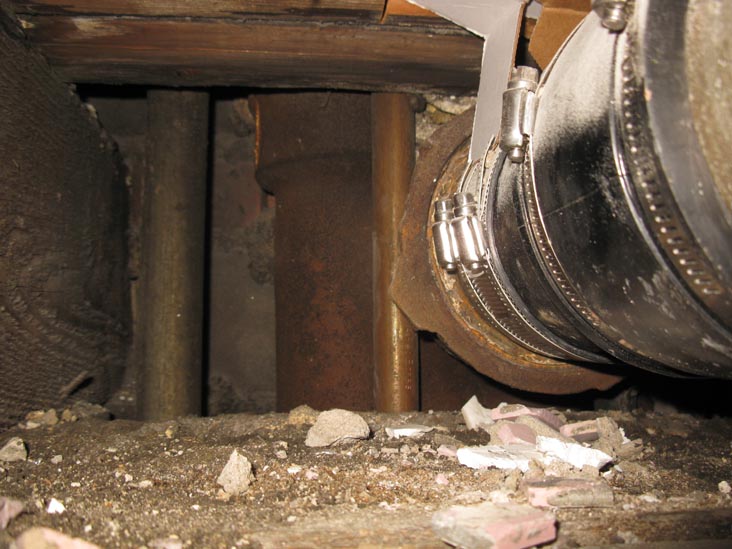
One thing they did that was odd — or at least I thought it was odd — was that when they needed a piece of cardboard to use as a bed for the cement around the toilet where they poked through the floor to install the new waste line, they just grabbed a pizza box out of the recycling. I mean, I guess it was clean:
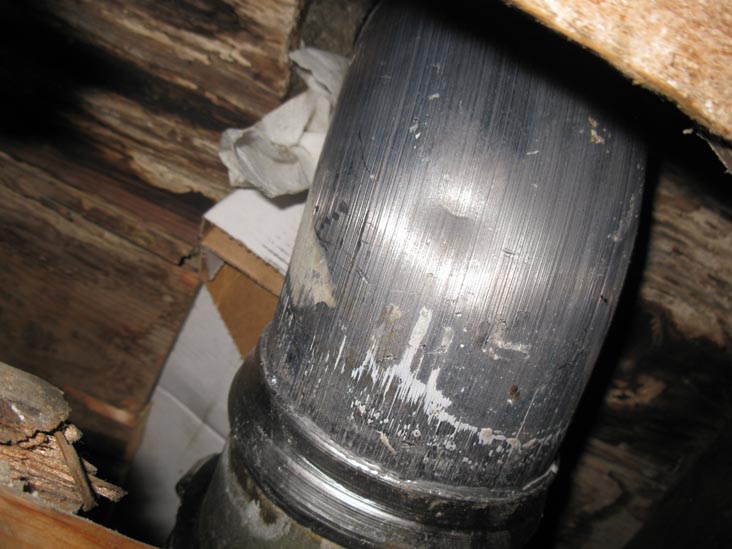
So one lesson I took away from all this is that I now know why the previous owners added drop ceilings:
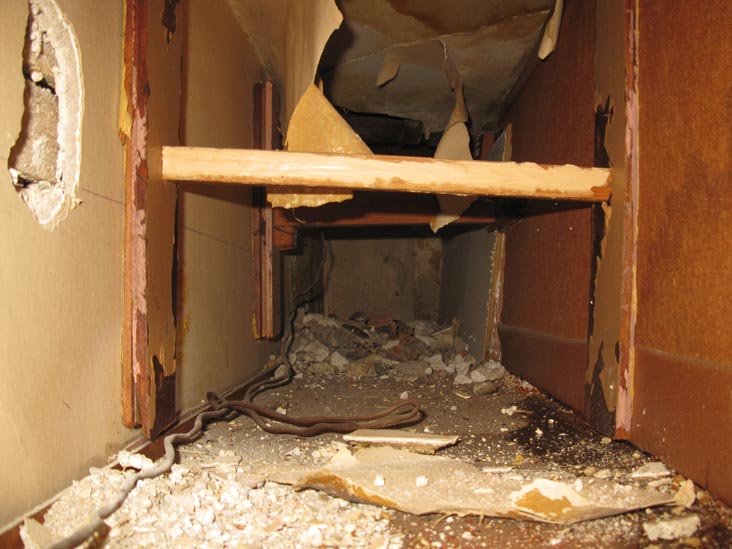
I guess waste lines poop out over the years and fuck up the ceilings.
It occurred to me that there were drop ceilings all around the house. Or more specifically, there were drop ceilings where plumbing was concerned: the kitchen, the bathroom, our bedroom (it being under the kitchen on the third floor). It's a lesson worth remembering: If you see drop ceilings, ask what's under those tiles. So yeah. That.
Cleaning up afterward, I had to retile the bathroom floor around the toilet, clear out the debris that fell (or at least as much as I could), and fix the ceiling tiles in the kitchen. While fixing the walls around the cabinets, I found where past handymen had plugged up various holes with newspapers. The pizza box suddenly made sense: grab whatever was on hand and plug up a hole.
I found two eras of newspapers. The first was a The New York Times from 2010. Actually, it was the business section from July 25, 2010, based on this article and this article. Things made sense: They must have done some work in 2010 in anticipation of selling the house. Maybe that's why the stove looked so new. It's probably when they painted the tile orange (don't ask; or, more accurately, we'll get to that, I suppose).
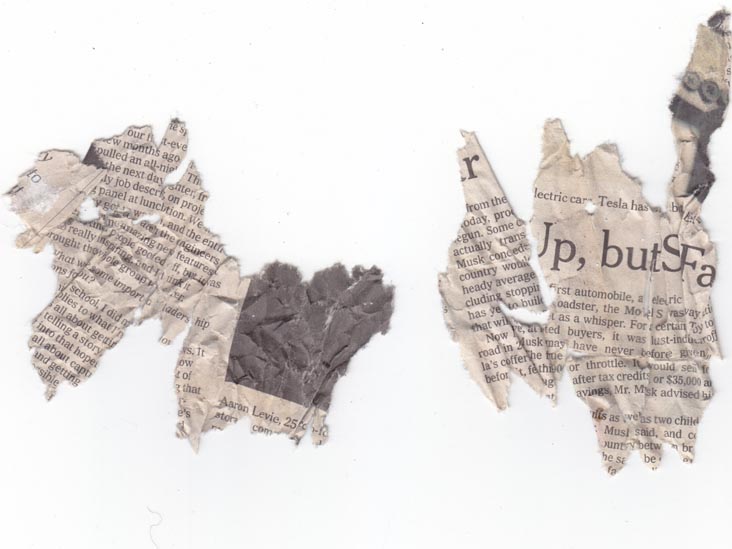
Then there were the other pieces of newspaper shoved into spaces into the kitchen wall — and it corresponded to what I assumed to be the age of the kitchen, at least judging by the tile. These look like they're from the 1960s, and they probably are:
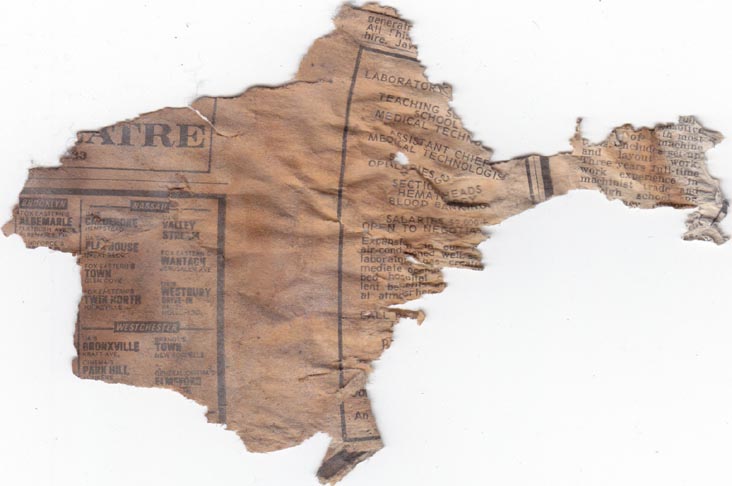
The ad for the "burlesk" theater seems to be the Mayfair Theater on 235 West 46th Street; it shows up in this issue of New York Magazine from 1968. I think it's a Dean & Deluca now:
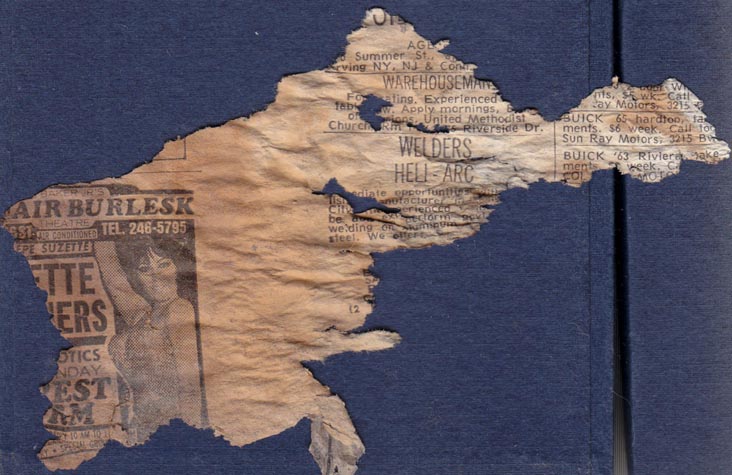
Another clue — these pages look to be real estate classifieds. One notice (on the left) talks about some Mitchell-Lama project, with the requisite honorific shoutouts to those in charge: Governor Rockefeller, Mayor Lindsay and Commissioner Gaynor. Rockefeller was governor from 1959 to 1973. Lindsay was mayor from 1966 to 1973. But James W. Gaynor was New York State Commissioner of Housing and Urban Renewal until 1969. So this is from before 1969. Again, guessing the late 1960s (especially with those ads for mid-1960s Buicks in that second image):
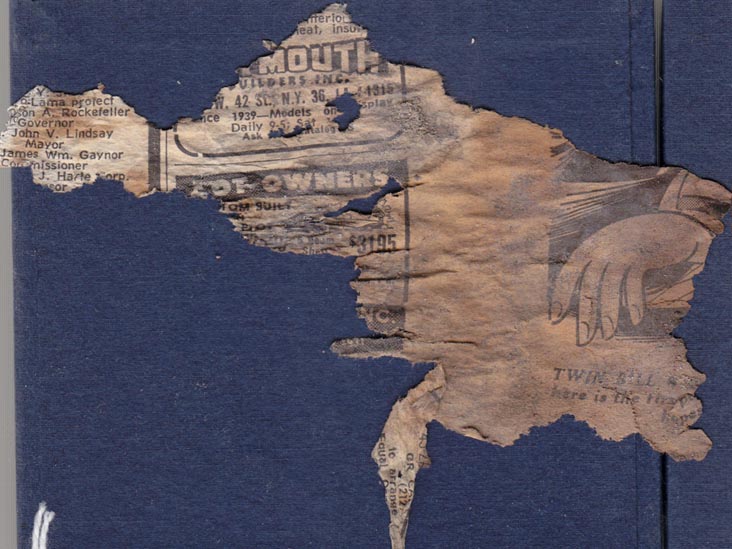
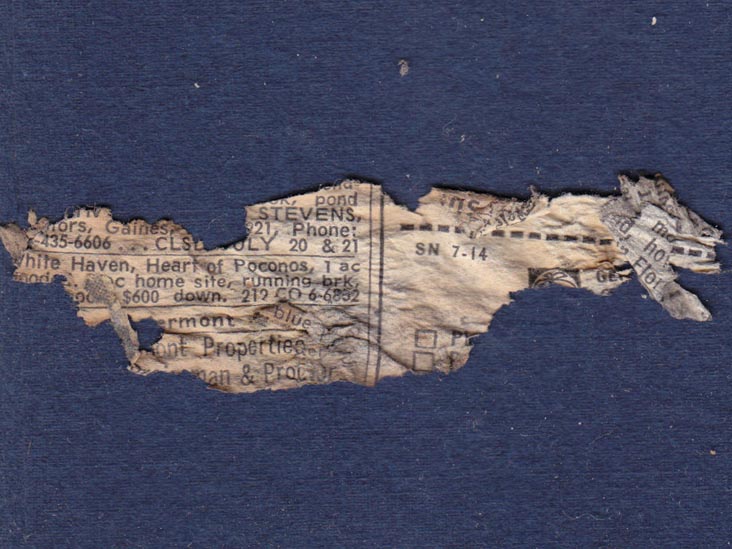
Which is to say, the walls hold clues: Destroy the toilet waste line and dig around, you'll find something.
Posted: February 10th, 2012 | Author: Scott | Filed under: The Cult Of Domesticity | Tags: Grabbing The Wax Ring, Kawama, New York State Commissioner of Housing and Urban Renewal James W. Gaynor, The Golden Age Of Burlesk, The Problem With Indoor Plumbing
So a few words about toilets.
The toilet that was in the house was a beautiful old pink toilet. We weren't exactly sure when it was from but it was from a ways back.
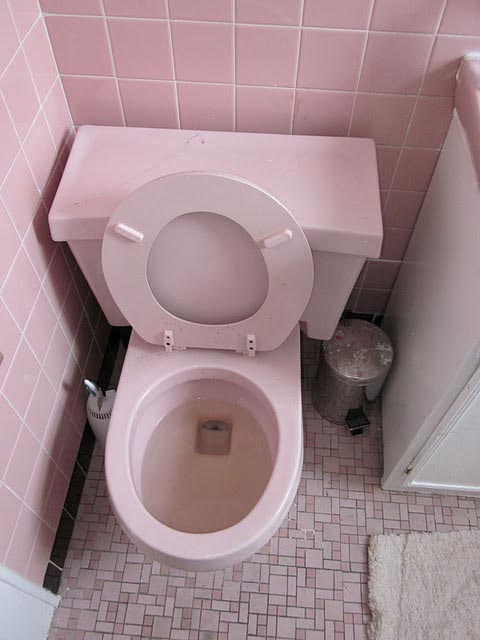
It was also giant bitch of a toilet. It took about ten minutes to fill after you flushed it. It was like riding around in a pink ceramic Cadillac.
As renters, we never had to think about water rates or water bills or anything about the water other than we were entitled to it.
As homeowners, every time we flushed that bitch of a toilet we thought about the water bill — and the longer it took to refill — every 30 or 40 seconds (or ten minutes) of listening to water drain, drain, drain into the tank — the more it shook you to your very core.
But like I said, it was a beautiful pink toilet. Of course the lid was cracked in two, and there was the slightest hairline fracture in the bowl itself, which, if you didn't clean the toilet for a few days, developed just a hint of a funk-mold hairline that waved in the current when the toilet flushed. Which is to say, we probably needed to replace the toilet.
Now when you get to replace a toilet there's a certain thrill in shopping for the most water efficient model ever created. You study the liters-per-flush stats and it just kills you how fucking green you are being. It hurts.
The only thing with buying a new toilet is that there are only three colors they really make: white, off-white and black. With our pink and black tiles, that left us just one real choice — black. The rock 'n roll toilet.
When it came to paint colors, I deferred entirely to Jen. When it comes to most style decisions, I defer to her. But for some reason I was really adamant about having a rock n' roll toilet. It just looked so correct. So that's what we did. We bought a rock n' roll toilet. And a rock n' roll toilet seat to go with our rock n' roll toilet.
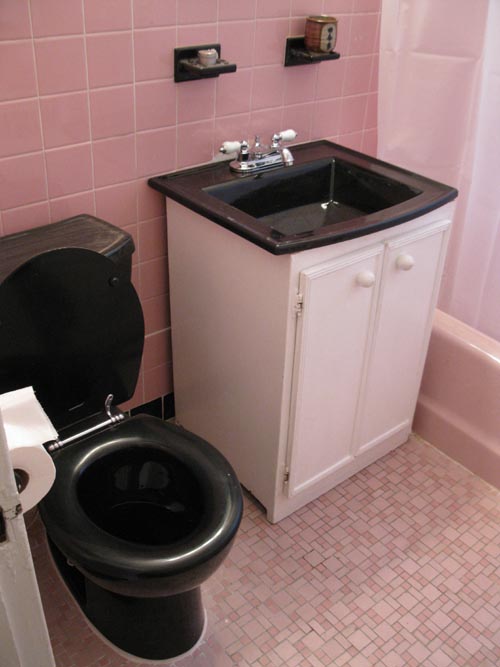
The other thing that was sweet: You can buy a toilet on Amazon and they will deliver a toilet to your house. I don't know how we would have done it otherwise.
How hard is it to install a toilet? Like everything else — negotiating real estate, pruning rose bushes, raising children — you Google it. It's pretty straightforward, though I did have to go to more than one place to find a flange — the thingy that attaches to the subfloor that holds on the toilet itself (what those two bolts at the bottom do).
That said, there is the issue of the wax ring. If you've never unhooked a toilet from the floor, the wax ring is a ring of wax that globs together the toilet pedestal to the flange and seals the waste line from the rest of the bathroom. The only tricky thing about the wax ring is that after you glob it to the bottom you don't really see it once you set the toilet on the floor — so there's really only one shot to get it right. After it's on there, it's hidden from view for as long as you want to ignore it.
There's nothing like the feeling of accomplishment after installing a toilet and flushing it for the first time. And not seeing water seep out from the bottom of the base of it after you do so.
There is of course an irony in installing a water-efficient toilet: You (meaning I) are (am) much less likely to "let anything mellow" on the theory that you're never really wasting water with a water-efficient toilet. It's the kind of perverse logic that says that bicyclists and football players are safer without helmets.
I couldn't bear to part with the pink toilet completely, so I convinced Jen that we should install it in the backyard as a planter, as a way of sort of respecting the history of Kawama. It's not the ideal thing to plant stuff in — but not because of what you're thinking. Rather, a toilet is designed to hold water in the bowl, which means that it doesn't really drain correctly, which means that it kind of sucks as a planter. The stuff we had growing in there this summer did OK (a fern and some leftover hosta plants that were in the backyard when we moved in), but I don't know that we'll plant, say, herbs in there anytime soon. Like I said, drainage issues — plus, it's kind of gross to think about anyway. This isn't the best image — it's actually from August on the day before the hurricane/tropical storm hit when it was really raining — but you can see what we did:
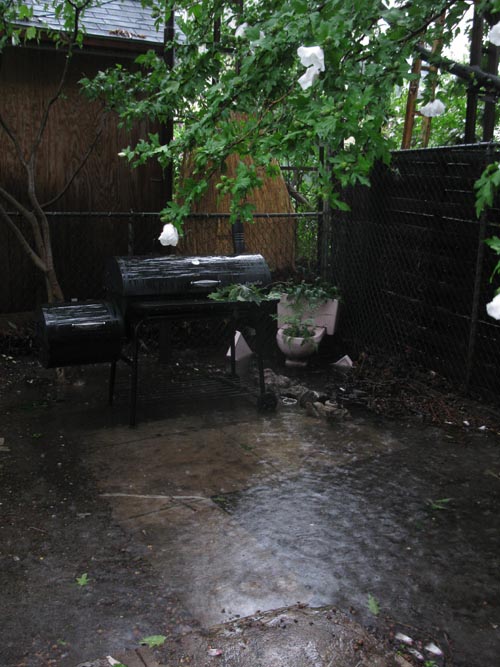
In the end, I finally figured out when the bathroom dates from — it turns out that every toilet bowl basically has a date stamp. So this one says (if I can make it out correctly) "Nov 29 1965." Which means it was made the Monday after Thanksgiving in 1965:
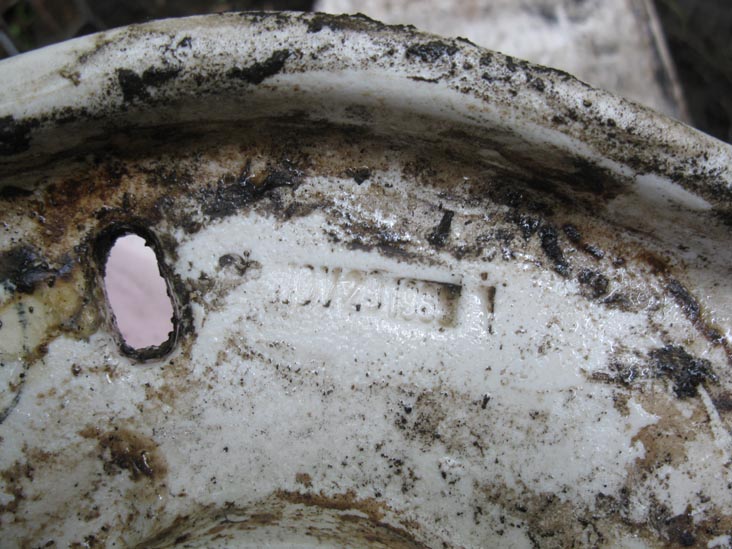
That makes sense when you look at the décor of the bathroom — it's basically 1960s. Our rock n' roll toilet has a date stamp of sometime in March of 2011 (I forgot to take a picture of it before I installed the toilet).
Posted: January 22nd, 2012 | Author: Scott | Filed under: The Cult Of Domesticity | Tags: Googling Your Way Through Life, Grabbing The Wax Ring, Hostas Are Not The Nicest Plants But They Are Certainly Resilient, It Kills Me How Fucking Green I Am, Kawama














